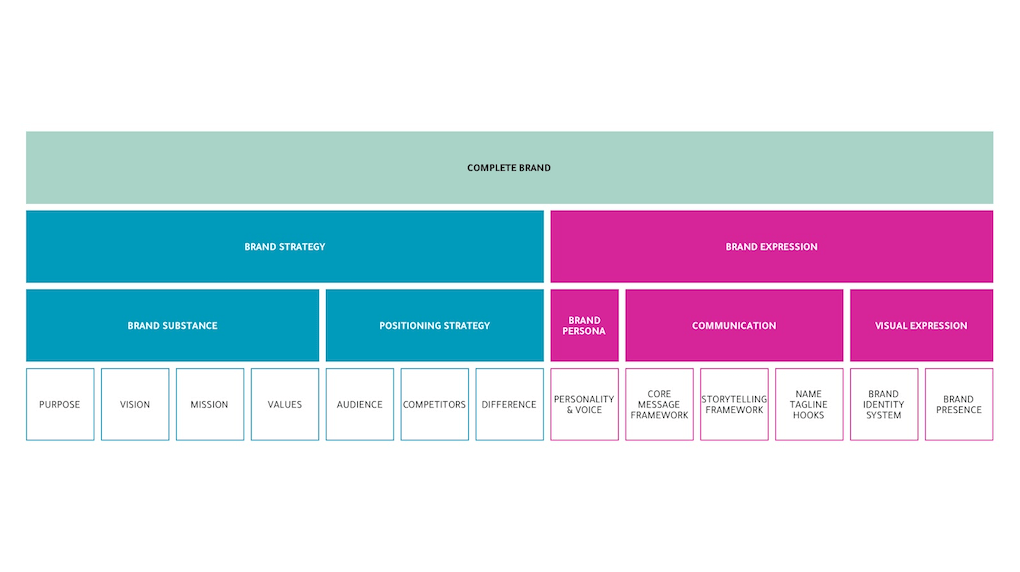You’ve got your brand book or your brand guide — now what?
You don’t want to be left holding an expensive yet useless document, so read on for a robust explanation of how to execute your brand guide and the rest of your brand book. After this article, you’ll have a high-level overview of what brand strategy implementation looks like.
This article will touch on a little bit of everything: from how we create brand guidelines within brand books along with our unique brand rollout checklist — this article is not, however, a brand guide template.

First, what exactly should your Brand Book accomplish?
What do Brand Books do?
- Keep your brand consistent across all channels and mediums
- Ensure your standards are always met
- Communicate who your brand is with specific, tangible directions
- Communicate why you do what you do — beyond making a dollar
What this means for your brand
The importance of the first two points is obvious: consistency breeds credibility. That’s just branding best practices.
The third and fourth points may seem subjective. When executed correctly, however, they bring a positive ROI. This is because your audience will put their purchasing power behind brands that relate to them. It comes down to one simple truth: People don’t buy products. They buy better versions of themselves.
First, let’s go through the DNA that makes a brand
The chart below is the unique way we at Major Tom approach branding. By breaking everything down into categories and blocks, we can see the holes in a client’s existing brand book or, if we’re starting from scratch, this gives us a brand rollout checklist.

A complete Brand Book involves two large parts: your Brand Foundations and your brand guide.
Your brand foundation contains all the elements that make up your brand strategy. This is your brand substance and position. As you can see in the chart above, the brand strategy involves the substance (the core of who you are) and the market position (who you serve and where you stand) of your brand.
Your brand guide contains all the elements that make up your brand expression. This is who you are, what you look like, and how you sound. Your brand expression encompasses everything you need to show your brand to the world.
An easy way to differentiate these pieces is brand expression = external, brand strategy = internal. Though, you can make exceptions to the rule. It’s your brand, after all.
A brand book communicates and explains either all or some of these blocks. By tailoring brand books to your organization's needs, you’ll end up with a document that serves your business and your goals. To best tell your story, our team needs to know who you are and where you’re headed — so we start everything with a discovery phase.
The marker of a high-quality brand book
If you’re involved in the world of marketing, you’ve likely come across a number of brand guides. As you can tell, some have better clarity and value than others. While the intent of your brand guide is to communicate your brand and ensure consistency, it must also be clear. Brand implementation will be extremely difficult if your brand book only has high-level concepts and no practical execution.
A how-to guide for brand book implementation
It’s important that everyone within your organization not only has access to your brand book, but also understands it. You should be actively using your brand book to guide business decisions and consider it a standard that you can hold your entire company (including yourself) against. In short, branding best practices include a useful and used brand book.
Brand Strategy: Your brand substance

Purpose
Your purpose is what your company believes in, the reason — besides commercial gain — that you operate. People make decisions with their hearts; your purpose gives your audience and your team a reason to believe in your brand.
To implement your purpose, use it as a guide to shape your brand’s emotional benefits. Your brand’s purpose can influence your brand position and your brand communication.
Vision and mission
Your vision is meant to keep everyone pulling in the same direction. You can implement it throughout your organization by ensuring everyone who works for or with your brand knows your vision.
Your mission encompasses the steps you and your team take every day to accomplish your vision. Your mission may be used as part of your organization's overall strategy. If your vision is to X and your mission is Y, then you will need to do ABC to get there. So, you can implement your mission by breaking down your mission into actionable steps needed to achieve it.
- Know your vision
- Identify the steps to achieve said vision (your mission)
- Break those steps into the actions needed to complete them
Values
Your values act as guiding principles for every decision you make as an organization. You can look at Major Tom’s hiring practices for an example of how to implement values. When hiring, we make sure to search for our values within candidates. We do this by using our values to structure part of our interview process. These values are then used as a measurement during employee reviews. In this way, they shape our hiring decisions and, as a result, our culture. Because they are so important to us, we have chosen to publish them on our website — this way, prospective clients and employees can get a feel for who we are before they choose to engage.
Major Tom’s values are:
- Have an adaptable attitude
- Be a plus person
- Bring a curious mind
- Own your impact
- Lead with a humble heart
Values can also be implemented in other areas of your organization. We keep ours in mind when executing projects and deliverables for clients — everything we do can point back to these in some way. It is important to note that these values are open to interpretation — there is no exact way to implement them because they are meant to be used as a guide.
Brand Strategy: Your positioning strategy
Your positioning strategy allows your brand to occupy a place in the mind of customers so when customers think of ‘x problem’ they think of your brand with ‘y’ solution. The intent is to create brand recall. To do this, we begin with understanding your audience and researching your competitors, then find your difference.
Implementing your positioning statement involves using it to influence a larger communication strategy. Because your positioning actually happens in the mind of your audience, you need to influence the way they perceive you. To influence the way someone perceives you, you must be specific in the way you present yourself. So, your positioning statement should give all of your communication (visual and voice) direction.
For example, Coca-Cola’s positioning statement includes spreading happiness — all of their communication is joyful. You can feel it through their iconic red, down to their tagline, previously “Open Happiness” and now, “Taste the Feeling.”
Brand Expression: Your brand persona
Your brand persona — which is different from your audience personas — is how you communicate your brand. We use Jungian archetypes to determine your brand persona. They act as a way to connect with your audience from a human perspective instead of a purely transactional one.
Implementing your persona is to use it as a starting point for your communication style. This will keep your communications consistent and familiar. To implement this persona, use it to influence your tone of voice and shape the language and vocabulary used in your messaging.
Brand Expression: Your Communication
Your brand communication incorporates your core messaging framework, storytelling framework, name, tagline, or hooks.
Your core messaging framework includes what you want your audience to understand about your brand, which is expressed through primary and secondary key messaging. This messaging framework should not be used verbatim. It should be used to give your copy or content writers an idea of what is important to you and your audience. Implement the core messaging framework by handing it to your writers to use as a reference for what to talk about.
Your storytelling framework tells the story of your audience’s journey as it relates to your brand. This framework puts your user in the role of the hero. This is not intended to be used as a selling mechanism. This is intended to be a method to build relationships with your audience. Implement this by giving it to your writers as a tool for understanding how your brand’s narrative works.
Brand Expression: Your visual expression
Your visual expression involves your brand identity system — your logo, colors, typography, imagery, iconography, illustrations, video, decks, etc. — and your brand presence — website, social channels, and any physical collateral.
To implement your visual expression, give everything to your designer. A brand guide is not an explanation of how to design, nor does it act like a template where you can plug elements together to create a finished product. A brand guide’s visual expression is just that — a guide.
When designing from a brand guide designers know not to evolve what’s already there, but rather to take the elements and create from them. Any designer worth their salt knows that a guide is something to work from, not to work to. A guide offers the core elements of a brand and allows you, as the designer, to create from those elements. What they create should feel on par with what is in the guide, not a departure from it. This is branding best practices.
What next?
Your brand guidelines fit into your overall strategy by keeping you consistent, humanizing your brand to your audience, and expressing your values, beliefs, and philosophies to the world. Of course, this can only happen when everyone has access to and understands your brand book. All of this being said, this document can (and should) evolve and grow with your organization.
If you need help with either creating or implementing your brand guidelines, let's chat.